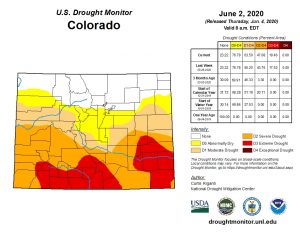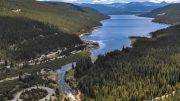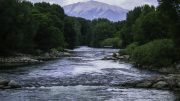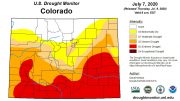Arkansas River Basin streamflow forecasts range from a low of 22 percent of average for Grape Creek near Westcliffe to a high of 82 percent for the Arkansas River at Salida.
In its June Colorado Water Supply Outlook Report, the Natural Resources Conservation Service attributes the below-average numbers to early snowpack melt, dry conditions in the late summer and fall of 2019, and dry conditions in April and May.
The report documents precipitation in the Arkansas Basin at 36 percent of average for April and May. Water stored in Arkansas Basin reservoirs is also below normal at 87 percent of average, and storage in the Rio Grande Basin is at 62 percent.
Statewide, the report indicates 49 out of 115 snow telemetry sites in Colorado received the lowest or second lowest precipitation amounts on record for April and May.
While the southern half of Colorado is drier than the northern half, the report states that all Colorado river basins “are now projecting below average forecasted streamflow volumes” for June and July.
During the May 28 meeting of the Governor’s Water Availability Task Force, NRCS Colorado Snow Survey Supervisor Brian Homonkos reported that Rio Grande Basin snowpack was “entirely melted out.”
He also reported precipitation for the Rio Grande Basin at 15 percent of normal for April and 28 percent for May.
Consequently, the NRCS report projects flow volumes for all rivers draining the Sangre De Cristo Range at below 35 percent of normal.
Homonkos also reported that statewide snowpack has decreased from slightly above normal at its peak in early April to 69 percent of normal by the end of May due to below-average precipitation and snowpack melt rates “well above normal.”

During the Water Availability Task Force meeting, State Climatologist Russ Schumacher reported that April 2020 was the sixth driest April on record. “You can see a lot of the places in the Arkansas Valley being in that 0-20 percent of average rainfall in April.”
Schumacher reported that drought conditions have intensified, “especially in the San Luis Valley, the Arkansas Valley and parts of the Western Slope.”
The situation in southeastern Colorado, he said, “looks to get worse before it gets better” with an uncertain summer monsoon precipitation outlook and “temperature very likely to be warmer than average, especially in western Colorado.”
- Conservancy districts oppose major water purchase by Aurora - April 15, 2024
- ARWC releases February River Report - March 10, 2024
- State official to discuss water administration changes today in Salida - March 8, 2024





You must be logged in to post a comment.